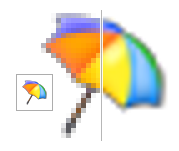Raster graphics
A raster graphic , also pixel graphic (English raster graphics image , digital image , bitmap or pixmap ) is a form of description of an image in the form of computer-readable data . Raster graphics consist of a raster-shaped arrangement of so-called pixels (picture elements ), each of which is assigned a color . The main characteristics of a raster graphic are therefore the image size (width and height measured in pixels, colloquially also called image resolution ) and the color depth .
The generation and processing of raster graphics falls into the field of computer graphics and image processing . Another way of describing images is vector graphics .
Applications
Raster graphics are suitable for displaying more complex images such as photos that cannot be described with vector graphics. Raster graphics can be digitized from existing material - for example with a scanner or digital camera - or created with image processing software .
The pixels of a raster graphic can only contain information such as color. In the latter application areas, raster data have the disadvantage compared to vector data that they are relatively imprecise and are poorly suited for topological analyzes.
Minimalist pixel graphics have now become a popular art form. The spectrum of the so-called pixel art ranges from mobile phone logos on websites to TV commercials and advertising posters . In terms of their nature, pixel graphics are similar to traditional techniques such as mosaic and cross embroidery .
Spread and problems

Today's computer screens are sold exclusively through a raster graphic that the framebuffer driven is stored and contains the whole screen. Therefore vector graphics must be rasterized before output . A raster image processor does this for output on some printers . All printers with linear paper feed are suitable for the reproduction of pixel graphics, while plotters should be controlled with line-oriented vector graphics.
The most popular graphic formats for raster graphics are BMP , GIF , JPEG / JFIF , PNG and TIFF . Some of these formats employ lossless or lossy image compression .
One of the disadvantages of raster versus vector graphics is the usually relatively high memory consumption. Since raster graphics only consist of a limited number of pixels, two-dimensional geometric shapes are only approximated. The staircase effect or even the aliasing effect comes to light, which can be dampened by means of antialiasing . In the case of geometric transformations of a raster graphic, such as scaling , information can be lost or color tones can be generated that were not previously available.
conversion
The conversion of a vector graphic into a raster graphic is called rasterization . This process takes place every time a vector graphic is displayed on the screen or printed out.
The opposite way, the so-called vectorization of raster graphics, is much more difficult. It can be done manually by tracing, or using special functions of a vector graphics program such as the Trace Bitmap function from Inkscape , or also using specialized programs such as Corel PowerTRACE or Potrace . This way is also often prone to errors, since graphic primitives such as straight lines, circles or curves are only inaccurately depicted in the raster graphics and therefore cannot be recognized exactly. Particularly big problems arise from color or brightness gradients in raster images which are only insufficiently approximated during vectorization as discrete bands ( banding ).
See also
literature
- Burger, Wilhelm and Burge, Mark J .: Digital Image Processing: An Algorithmic Introduction Using Java . First edition. Springer, 2008, ISBN 978-1-84628-379-6 .
- Shirley, Peter and Marschner, Steve: Fundamentals of Computer Graphics . Third expanded edition. Taylor & Francis Ltd., 2009, ISBN 978-1-56881-469-8 .